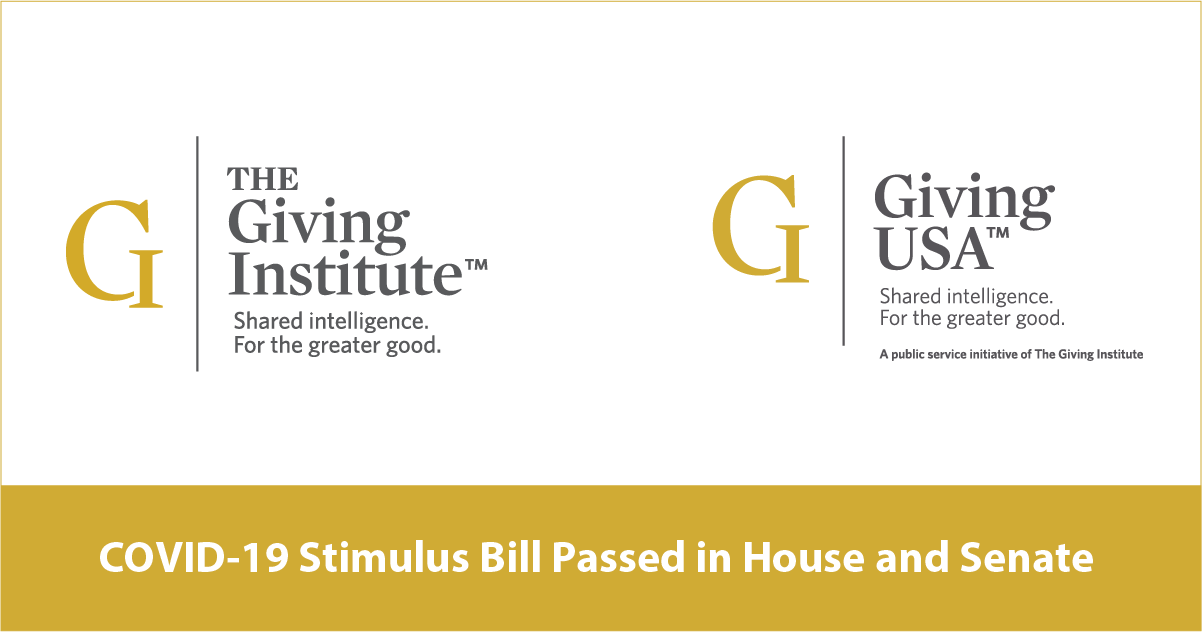
From an update provided by The Giving Institute
On Thursday, the Senate passed the coronavirus stimulus package in a 96-0 vote. The House voted today to pass it as well and it is expected that President Trump will sign it into law. Below are highlights of the bill’s provisions for nonprofits:
Creates a temporary universal charitable deduction for non-itemizers, for cash only, capped at $300. This provisions excludes gifts into donor-advised funds (but gifts to sponsoring organizations benefit) and 509(a)(3) supporting organizations. Congress clearly still believes that a gift into a DAF is not the same as a gift directly to a charity.
Temporarily suspends current AGI limits for charitable deductions for cash gifts made by individuals and businesses. This provision excludes gifts into donor-advised funds and 509(a)(3) supporting organizations.
- Individuals: total charitable contributions can be deducted up to 100% of a donor’s adjusted gross income (had been up to 60%).
- Corporations: charitable contributions can be deducted up to 25 percent of taxable income (had been up to 10%).
Allows nonprofit organizations (including foundations) with less than 500 employees to access $350B in loans from the Small Business Administration Provides.
- If conditions are met, these loans can be forgiven.
- Secretary Mnuchin said these loans will begin becoming available within a week.
Provides fully refundable tax credits to nonprofits (including foundations):
- If a nonprofit is subject to a shut-down order and has lost 50% of revenue compared with last year.
- They can receive up to a $5,000 per employee tax credit.
- Tax credits could be applied against payroll taxes so it’s an immediate benefit.
- Employers CANNOT take both the tax credit and SBA loans.
Checks and debit cards offering $1,200/taxpayer plus $500/child will begin going out shortly. But only for individuals making less than $75K/year and couples at $150K/year. (Lesser amounts to those making slightly more).
- Payments will automatically arrive within 3 weeks. No forms to fill out.
- Only for taxpayers, not dependents. So no students or some elderly.
Additionally, there are other provisions that could help you and your grantees:
- Allows employers to stretch out payments of their share of the Social Security payroll tax owed, with half the amount due by December 31, 2021 and the other half by December 31, 2022.
- Provides $150 billion to states, territories and tribal governments to use for expenditures incurred due to the public health emergency. Some of these expenditures could be grants or direct spending through grantees providing relief services.
- Provides $100 billion in grants to health care providers to help fight the coronavirus. This could go to grantees like heath care centers who are responding to the virus.
- Provides $30 billion in emergency education funding for colleges and universities, states and school districts. This could go to grantees in the education space.
- Provides $45 billion to FEMA’s response and recovery activities, with $400 million for grants that can be disbursed for firefighters, emergency managers and providers of emergency food and shelter. This could help emergency aid grantees, like the American Red Cross, respond to the crisis in a timely manner.
Further information:
You can read further analysis from our colleagues at the National Council of Nonprofits in this document, which may be helpful for your grantees.
Keep up the social distancing and be well. We will continue to share updates over the coming weeks.
Aly